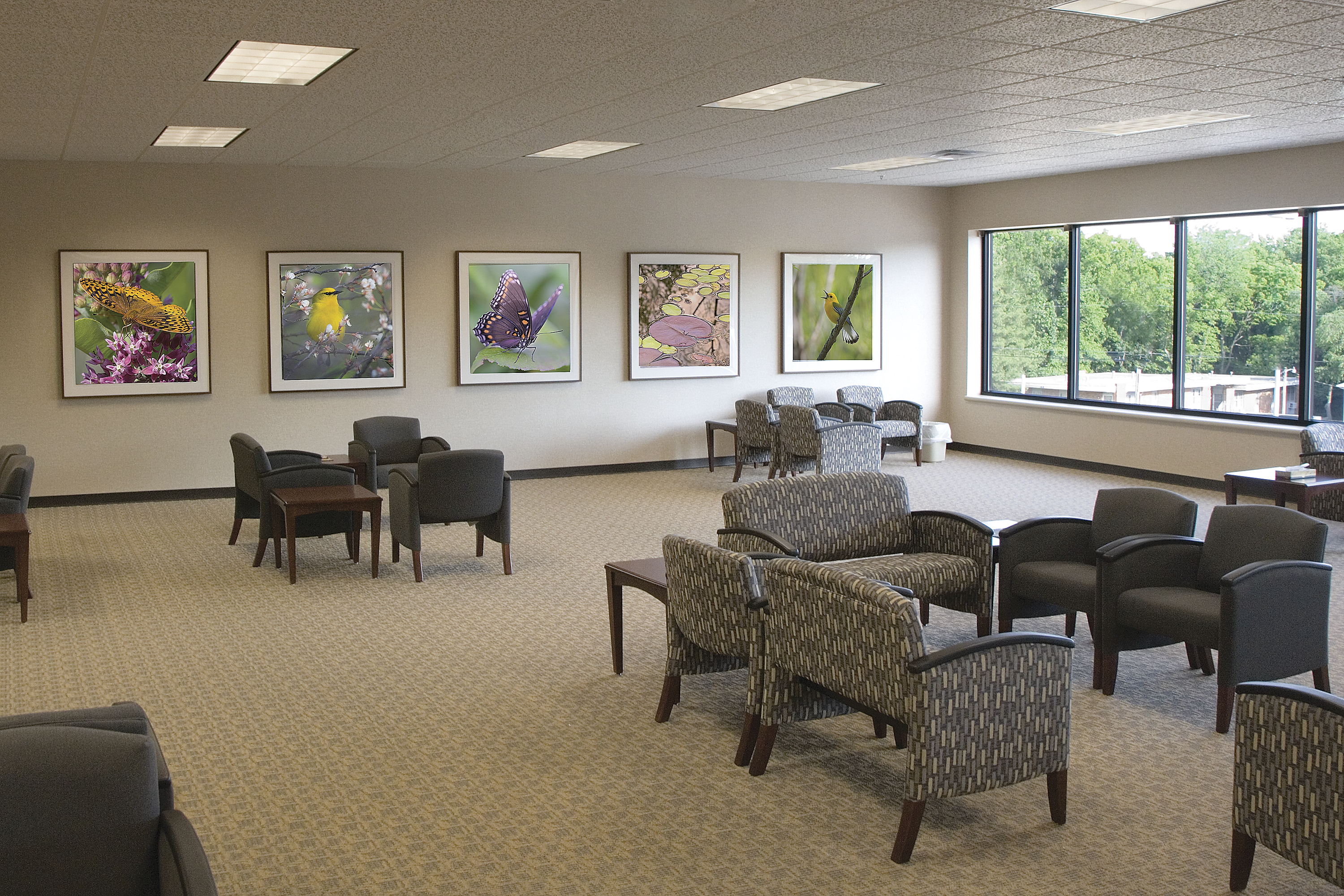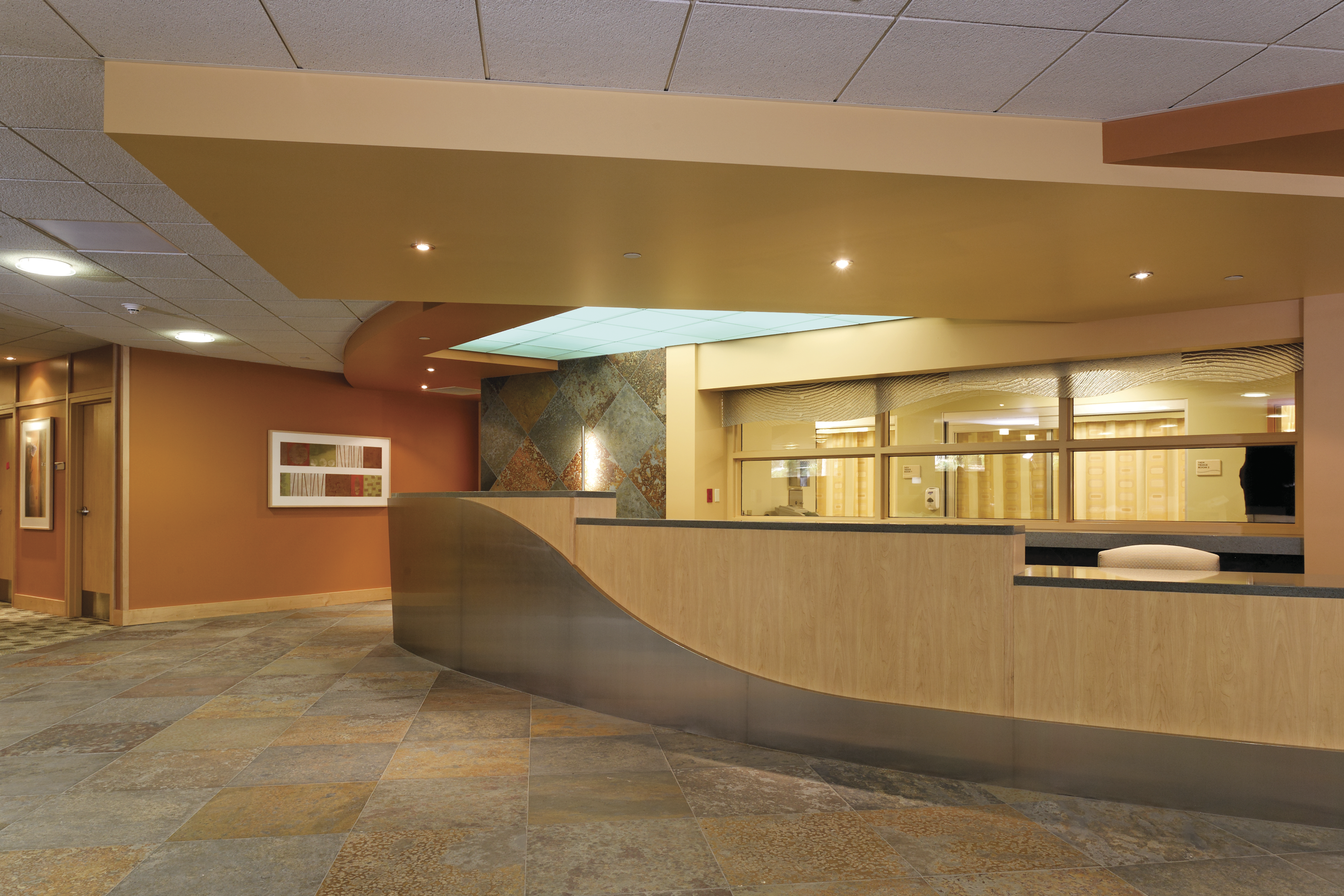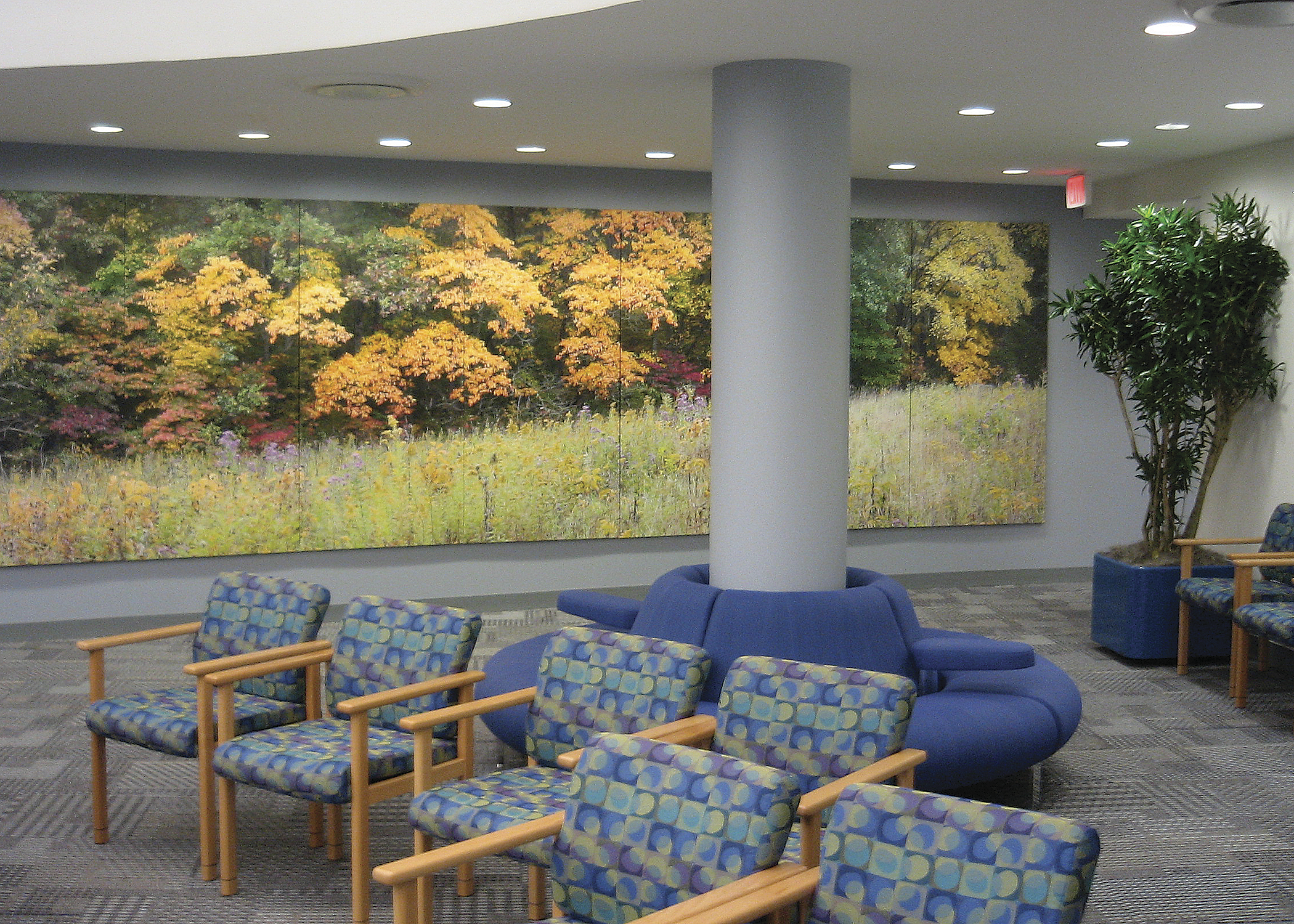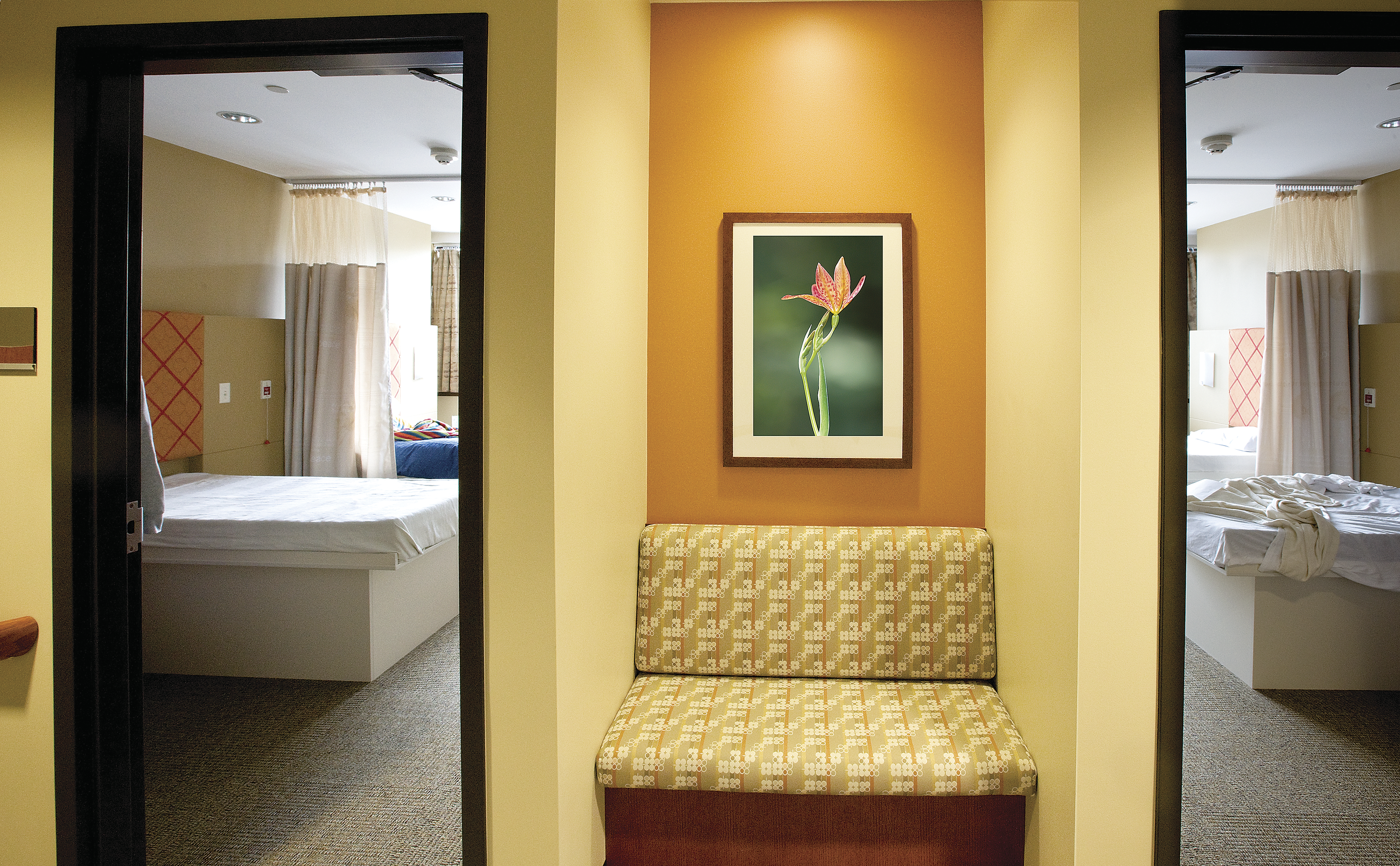
29 Dec Collector's Notebook: Palliative Pleasure
Prime-Care Physicians clinic in Albany, New York, is not a place people want to be. Whether actually sick, or working to stay healthy, patients enter the waiting room and run headlong into a 6-foot-high, 30-foot-wide image of a thick stand of trees. Stretched across the back wall, the picture is so clear, they can almost hear the birds chirp. Compelled to gaze a moment, they take a deep breath, and then another.
Florence Nightingale knew art helped people heal long before modern science began delving into the matter. In her Notes on Nursing, she wrote: “Little as we know about the way in which we are affected by form, by color and light, we do know this, they have an actual physical effect. Variety of form and brilliance of color in the objects presented to patients are actual means of recovery.”
Nightingale would like what hospitals and doctors’ offices are doing with art today, placing it intentionally in rooms, treatment areas and hallways to support patients’ recovery; using it to calm visitors and as way-finding markers in big facilities. Long-term care facilities are using art to stimulate visual perception in elderly residents and urge the wheelchair-bound out of their rooms. Visual art is even used in some surgical procedures to minimize pain.
The idea is to give patients a positive distraction, something to take their attention away from their circumstances,” said Henry Domke, a family practice doctor and artist. Images that invite patients to literally step inside the scene are optimal, he said.
Domke uses digital photography to make images that achieve just this effect; images of nature, often close-up, grasshopper’s eye views of plants at the peak of their life cycle. His works are made entirely for health care settings.
In the past decade there’s been a sea change in the way hospitals approach art. Thirty years ago, there was none. Twenty years ago, there was poster art here and there. Now, major hospitals are spending 1 to 2 percent of multimillion-dollar construction budgets on artwork. According to Domke, it’s because so many studies have shown patients benefit in tangible, measurable ways; and because in competitive health care markets, it helps the bottom line.
“If a hospital looks dismal, people aren’t going to want to go back,” Domke said. “If it’s a positive experience, if they felt more relaxed when they were there, if the beautiful environment counteracted some of the stress of being sick, trust me, they’re going to want to go back.”
Health care design experts trace the shift to a 1984 study in the journal Science by Roger Ulrich, PhD., Endowed Professor at Texas A&M University’s School of Architecture. Ulrich compared two groups of patients recovering from gallbladder surgery: those whose windows looked out at a brick wall and those whose windows looked out on a stand of leafy trees. He found that patients with the view of nature recovered faster and needed less pain medication. His research evolved and expanded and a decade later yielded concrete guidelines that many hospitals are now consulting when selecting art. Choosing realistic nature scenes for acute-care settings is recommended, he said; landscape images with visual depth or openness in the foreground and pictures of plants at the peak of life are optimal in settings where patients are really anxious. Interestingly, abstract art that is ambiguous, that leaves much open to interpretation can be troubling to vulnerable patients who can’t get up and walk away from it.
“Art is very powerful in hospitals,” Ulrich said. “These are not museum situations or peoples’ homes where they have control.”
Jon Huntsman, Sr., the businessman and philanthropist, is on a first name basis with cancer. He’s battled it four times, and lost both his mother and father to it. He said, for everything that’s known about treatments and survival odds, at the end of the day, it’s a mystery why some people recover and others don’t. In 1999, when he and his wife gave $100 million to build The Huntsman Cancer Institute (HCI) in Salt Lake City, their priority was to make sure the environment would be as healing as the medicine.
“You want to take away the [patient’s] anxiety and you want to take away the fear,” said Huntsman. HCI has an 800-piece collection. Paintings and photographs hang throughout the facility, many donated by former patients. Each room has at least one piece of art, a view of the mountains and the occasional moose or deer wandering up to the edge of the building and looking in.
Jain Malkin, an interior designer specializing in health care settings, said for helping patients in pain, images based on prospect-refuge theory work best. An open vista visible from the vantage of safety, through leaves or a bush for example. Malkin, an industry leader, began her career when hospitals were barren, a maze of infinity tunnels; hallways with naked walls that went on forever. She said abstract art can have a place in health care, in lobbies or cafeterias. But in procedure areas and patient rooms, realistic nature or landscape images are called for.
Francie Kelley, a Los Angeles-based art consultant and owner of Paragone Gallery, just installed 450 photographs in the University of Southern California’s (USC) University Hospital. The designer was shooting for a spa-like environment. They selected 15 Domke images for the hallways and three images by Jennifer Broussard for each room. Both artists specialize in close-up nature images. “They’re very, very beautiful,” Kelley said.
Domke’s art business has grown so busy, he was forced to choose between medicine and art. He picked art. “The key goal of art in the health care system is to reduce stress. And that reduction of stress can contribute to the healing process,” said Domke. “But the whole approach is very alien to most people in the art world. Picking art for the way it functions … what a weird idea.”
Isabelle T. Walker is a Santa Barbara-based freelance writer with a special interest in health. She is a two-time California Endowment Health Journalism Fellow and author of the blog, Homeless in Santa Barbara, at www.homelessinsb.org.
- Jain Malkin designed the interior of Eisenhower Medical Center in Rancho Mirage, California. Relying on the research of Roger Ulrich, PhD., Malkin is a key pioneer in the burgeoning field of health care design.
- A waiting room in Albany’s Prime-Care Physicians Clinic features a huge digital print of a meadow and stand of leafy trees. The physician-artist Henry Domke created the image expressly to distract patients from thoughts of illness and uncertain outcomes by drawing them into the natural scene.
- Art in health care facilities can include textural glass sculpture, like this installation, also designed by Malkin.
- A digital image of a single lily in crisp focus, by Henry Domke, encourages relaxation at the Park Nicollet Melrose Institute in St. Louis Park, Minnesota.










No Comments